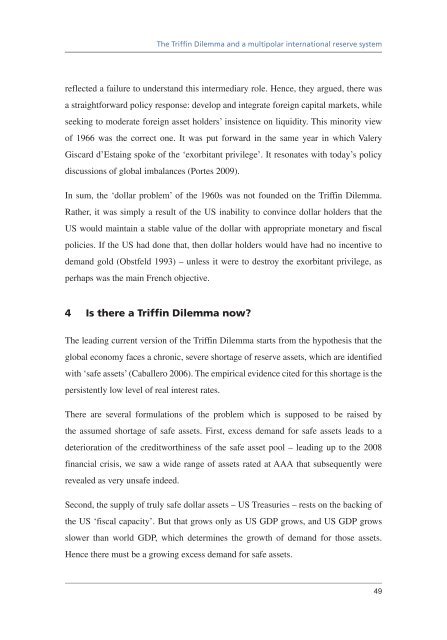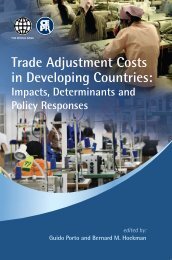Download PDF - Vox
Download PDF - Vox
Download PDF - Vox
- No tags were found...
You also want an ePaper? Increase the reach of your titles
YUMPU automatically turns print PDFs into web optimized ePapers that Google loves.
The Triffin Dilemma and a multipolar international reserve systemreflected a failure to understand this intermediary role. Hence, they argued, there wasa straightforward policy response: develop and integrate foreign capital markets, whileseeking to moderate foreign asset holders’ insistence on liquidity. This minority viewof 1966 was the correct one. It was put forward in the same year in which ValeryGiscard d’Estaing spoke of the ‘exorbitant privilege’. It resonates with today’s policydiscussions of global imbalances (Portes 2009).In sum, the ‘dollar problem’ of the 1960s was not founded on the Triffin Dilemma.Rather, it was simply a result of the US inability to convince dollar holders that theUS would maintain a stable value of the dollar with appropriate monetary and fiscalpolicies. If the US had done that, then dollar holders would have had no incentive todemand gold (Obstfeld 1993) – unless it were to destroy the exorbitant privilege, asperhaps was the main French objective.4 Is there a Triffin Dilemma now?The leading current version of the Triffin Dilemma starts from the hypothesis that theglobal economy faces a chronic, severe shortage of reserve assets, which are identifiedwith ‘safe assets’ (Caballero 2006). The empirical evidence cited for this shortage is thepersistently low level of real interest rates.There are several formulations of the problem which is supposed to be raised bythe assumed shortage of safe assets. First, excess demand for safe assets leads to adeterioration of the creditworthiness of the safe asset pool – leading up to the 2008financial crisis, we saw a wide range of assets rated at AAA that subsequently wererevealed as very unsafe indeed.Second, the supply of truly safe dollar assets – US Treasuries – rests on the backing ofthe US ‘fiscal capacity’. But that grows only as US GDP grows, and US GDP growsslower than world GDP, which determines the growth of demand for those assets.Hence there must be a growing excess demand for safe assets.49














